The History of a Canvas
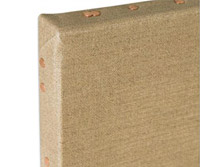
Canvas has been the most commonly used painting surface for centuries. There are surviving examples of paintings on canvas from as far back as 1410, but didn't gain wide popularity until the 16th century. The shift to canvas was a movement headed by Venetian artists, who had ready access to local sail cloth, considered superior to other woven cloth.
Stretched canvas was originally made from hemp. Linen (created from flax) was found to be smoother and more durable, and soon replaced hemp in popularity. Linen is still widely used today, but has been surpassed in popularity by cotton canvas, which is a bit more readily available, and much more economical than its flax counterpart. Recently, some manufacturers have begun experimenting with synthetic fiber as material.
What is a canvas?
Canvases are made from a woven fabric, most commonly made of cotton or linen (flax), usually stretched around a support, and then sealed with a sizing and ground to prepare the surface for painting with one or more of several media.
The Anatomy of a Canvas?
Originally made from hemp, makers chose linen (created from flax) found to be smoother and more durable, and soon linen replaced hemp in popularity. Linen is still widely used today, but has been surpassed in popularity by cotton, which is a bit more readily available, and much more economical than its flax counterpart. Recently, some manufacturers have begun experimenting with synthetic fiber as material. You Can choose from already made stretched artist canvas at anytime.
See Also:
Stretched Cotton Canvas or Stretched Linen Canvas
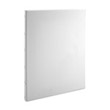
Most artists familiar with standard size, traditionally rectangular or square styles. Rectangular canvas is by far the most common shape and can be found in every depth, and with every common fabric type.
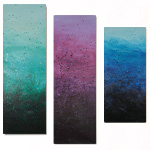
Ever try extra long or extra large canvas? The Edge All Media Cotton Stretched Canvas Extra Long Sizes have a slimmer width and longer height. Because they are extra-long and skinny (super rectangular), the shape naturally focuses attention. Imagine the different compositions you could paint on an extra long rectangular shape like The Edge! Each canvas is coated in a ground-breaking primer that maintains the richness and purity of your paint colors. Extra Longs/Longs/Multiples (triptych) - These used by themselves offer unique aspect ratios to achieve various single and multi compositions such as triptychs or diptych (artwork consisting of two or 3 pieces or panels that together create a single art piece). They work well also with squares or diamond shape. The 6x18" and the largest being 18x64", artists working in abstract impressionism have found these to be new heroes, to create unique multiple images that work together.
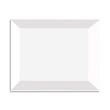
A relatively new type of profile is the beveled style profile, where the stretcher bars that make up the rectangular frame slope dramatically to either the front or the back. (Beveled Edge Canvas has the slope visible in the front and are not meant to be framed.
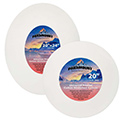
Round and oval canvas are not as common as rectangular, but consumers are usually familiar with that shape. You might recall seeing an old oil colour portrait on an oval or round hanging up in someone's home, or in an art museum. They are still sometimes used, especially for portraiture and provide a very unique and ornate look.
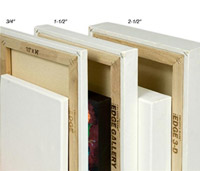
What is an canvas?
Canvas also comes in a variety of depths that can be anywhere from the slim ½" canvas to the boldly stated 3". The most common sizes one will probably see are the ¾" and 1½", and manufacturers often offer both these depths for consumers. The Edge all media pro canvas is available in ¾", 1½", 2½" and 3" depths. Frames that are 1" or less are the easiest to frame, but the Illusions floater frames have a series made especially for 1½" deep in several color options. This makes it convenient for artists who like to paint the sides, or have a deeper profile, but also wish to frame their work. Keep in mind frames can be adapted to fit (within a ½" range) with canvas offset clips. You'll almost always find canvas with a depth greater than 1 ½" to be gallery-wrapped, so the sides can be painted and the displayed without a frame. Not only is it impractical at that point to have a frame that deep (and that heavy), the point of the deeper edge is so that it can be painted
Two important things to take notice of when selecting your canvas are: a) how the material is secured to the stretcher bars, and b) the quality of stretcher bars themselves.
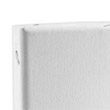
There are a few ways that the materials are attached to the stretcher supports. The first is side-stapled. This is found most commonly on very inexpensive, student-grade canvas. Galleries will rarely accept art on this type of canvas without a frame or it being back stapled. (Please note: Jerry's no longer sells any stapled on the sides, we only sell back stapled)
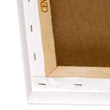
The second type of fastening, and easily the most common, is the gallery-wrapped canvas. This is a process where the materials are stretched around the bars, and stapled on the back. Most often the materials are folded at the corner, but some are actually cut, to eliminate that little ridge that the folded canvas creates. This is simply a matter of preference. However, if has been cut, that does make re-stretching it more difficult, should re-stretching be necessary.
NOTE:Galleries will often accept art on gallery-wrapped canvas without a frame, especially if the sides are also painted.
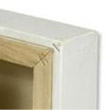
Finally, there are splined backs like the Centurion Deluxe Oil Primed Linen Canvas. Much like a gallery-wrapped canvas, the materials itself is stretched over the front and sides of the bars, and pulled around the back. Unlike gallery-wrapped style, there is a special groove in the back of the stretcher bars, into which the canvas is jammed, and then secured into place with a rubber strip that resembles a shoestring. These are often stapled on the back in just the corners, for added security. Splined backs can be harder to re-stretch.
All are made to have supports called stretcher bars, or stretcher strips, which are normally made of kiln-dried pine or fir. Stretcher bars provide the frame, strength, support and their depth. The thinner the bar, the weaker it is. So, to prevent warping, the bigger you want you the deeper (therefore stronger) you'll want the stretcher bars to be.
NOTE: most professional artists use higher depth stretcher bars to prevent warping and to insure the longevity of their work
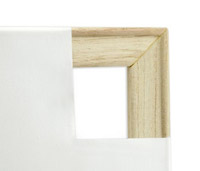
Canvas often has another bar going across the center in one or both directions. This is called a cross brace, or cross bar. Cross braces can go in either one direction, or both. When purchasing a canvas, make sure it has at least one cross brace if the size is 20x24 or larger, or two (one in either direction) if the size is larger than 30x30. If you're purchasing one where one dimension is twice the other (ex., 10"x20"), make sure your it has one cross brace through the center. If one dimension is thrice that of the other, (ex., 10"x30"), then check that your canvas has two parallel cross braces. This aids in warp prevention.
When selecting your canvas in a store, very gently press your hand against the stretcher bar on the front. If the bar is completely flat, you may notice a slight indentation about an inch to two inches in. This will only become more pronounced while you're painting, and you may very well end up with a little crease all the way around the inside of your painting, especially if you're heavy-handed. Good quality manufacturers use stretcher bars with a small rounded 'lip' on the outer edge that prevents the the materials from pressing against the rest of the stretcher bar. This helps to keep creases from forming during the painting process
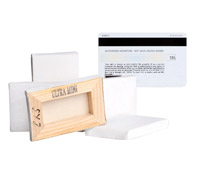
Need a really tiny canvas? Say, mouse-sized? It exists as a Mini Canvas. They are the same great quality just in a mini/smaller size. Need a massive, wall sized one? It exists too! And just about every size in between is either available or can be custom made here at Jerry's. Ultra-small's are fun, and an easy way to get creative. Artists can either create mini masterpieces. Artists looking to create murals or very large sized pieces of art are covered too. These giant sizes are good for theatre backdrops or just a way to ensure the mural you spent weeks on doesn't get rolled over when the painting crew comes in to redo the walls.
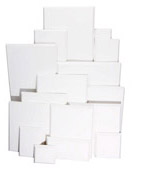
Artists sometimes find themselves with a particular canvas in hand, whether because the size just struck their fancy, or it's been collecting dust in the back of their studio for a while and they're tired of staring at it. They paint a gorgeous painting, and go to find a frame equally as gorgeous, and…wait, why are there no frames in this size? Or a consumer buys a painting they're in love with, and then find out they can't frame the painting unless they pay an arm and a leg for a custom job. It's an all-too-common frustration. Knowing standard sizes can really help cut down that annoyance.
Some of the most common sizes (in inches): 4x6, 5x7, 6x8, 8x10, 9x12, 11x14, 12x16, 16x20, 18x24, 24x30, 24x36, 30x40 Less common sizes that still have pre-made framing options (in inches): 6x6, 12x12, 10x20, 12x24, 12x36
There is a range of sizes that are rather popular, called 'panorama sizes'. Sizes such as 10x20, 10x30, 12x24, 12x36, etc., fit into this range. Some of these sizes are difficult to frame, but gallery-wrapped, especially 1½" and deeper can go without framing.
This is the part most people pay extra attention to, and for good reason. The surface type and how it is made itself is the part you work your magic on. The surface you choose can impact your work in many ways. Listed here are the four types of sufraces you'll find.
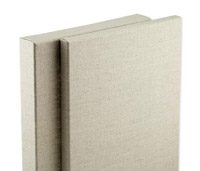
Linen
Of the professional canvas made today, stretched linen canvas is the oldest type. Made from the flax plant, linen is easy to spin into durable, uniform strands that are woven into varying weights and weaves to achieve different effects but it is more expensive. With some brands guaranteeing their linen to last 500 years, it's easy to see why artists concerned with preserving their artwork might choose linen. In addition to its longevity, linen is quite versatile.
Some of the finest grade portrait styles are linen. On the other hand, some of the most textured landscape pieces of art are also made of linen. Linen can be either acrylic primed (excellent for acrylics, acceptable for oils), or oil primed (excellent for oils only). Unfortunately, only a very few linen styles are worth the investment or available and the Senso Linen Canvas brand is one of the best lines of linen you can buy.
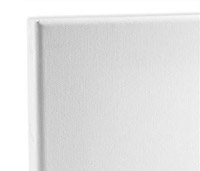
Cotton
Cotton has overtaken linen in popularity, mainly because of the reduced cost. Cotton is estimated to last about 100 years. Depending on how well it's cared for, it can last much longer. Cotton is usually only acrylic-primed, which is excellent for acrylics, but only 'okay' for oils. So, depending on your medium and concern with how archival your painting surface is, you may want to consider trying a cotton canvas (for a somewhat smoother canvas, try Paramount Professional Cotton Canvas or the Edge All Media Cotton Deluxe Canvas. For a more textured feel, you might like premium acrylic primed such as the Centurion LX Acrylic Primed Linen Stretched Canvas 3/4" Deep). Centurion is excellent for oil, acrylic, and alkyd colors and has a beefier stretcher suitable for larger size works.
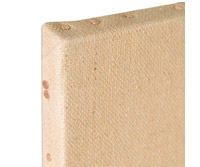
Jute
An unusual type of material worth mentioning is the jute. There are a couple of manufacturers that utilize this fiber for fine art purposes. Jute canvas is made from the spun vegetable fibers of the Jute plant, found primarily in India. It is a bit coarser than the average linen, and makes for a unique painting surface. Jute isn't anywhere near as popular as linen or cotton, but it has its own merits. For rolls, try SoHo Urban Artist Professional Jute Unprimed Canvas.
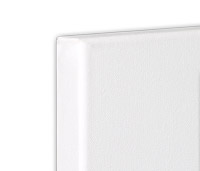
Synthetic
The newest addition to the fine art family is the synthetic made fibers and materials. Many manufacturers have been experimenting with synthetic, or man-made, fibers, and woven them with natural fibers to come up with something called Polyflax. Polyflax canvas tend to be very smooth, and excellent for portraits. It is also excellent for large sizes, given its considerable strength compared to cotton. Because polyflax is such a new notion, its archival qualities aren't really yet known.
Another Option is: Recycled Canvas, Cloth made from 100% recycled plastic bottles perfect for creating art sustainably! See - Liquitex Recycled Canvas
Whether you're interested in odd sizes, needing a particular surface that doesn't come in pre-stretched, or you just prefer to do it like the old masters, stretching your own is still a popular option. There is no end to the array of choices when it comes to materials, surface types and stretchers strips. While heavy duty stretcher bars can ensure that the larger you go they won't warp. Below, we look at some of the various points of stretching your own canvas.
Don't Want To Stretch Your Own Canvas?
The professional artisans at Jerry's Artarama offer custom in house custom canvas to suit your every need. Choose From Over 74 Canvas Styles, 9 Stretcher Bars. Jerry's has the largest selection of Custom Stretched Canvas! Whether you are new or a professional, our specialists are ready to help assist you in creating the perfect size. Call our Custom Canvas Stretching department and professional service team to help create the absolute best custom made to order one from the largest selection.
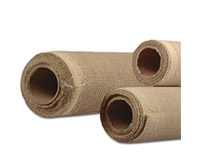
When stretching, you'll start with a canvas rolls or blankets. As discussed in the previous section, canvas comes in several different fiber types: cotton, linen, jute, or synthetic blend and can be unprimed, acrylic primed or oil primed. Rolls range widely in both weight, size and texture. Finally, the rolls themselves range in size, from 52" wide to 144", and from 6 yards long to 30 yards.
When deciding what type of to buy, consider your medium of use. If you're working with oils, you may want a linen or jute, which are ideal for oil colors (especially oil primed). If you're working with acrylic, tempera, or collage, you can choose any acrylic-primed surface with ideal results. If you work in watercolor or gouache, and are looking for a new surface to paint on, consider the Yes! All Media Canvas. It has a unique surface that allows it to accept watercolor.
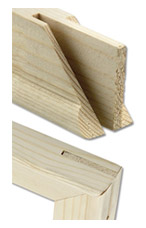
When stretching your own canvas, you can choose your own stretcher bars based on your need. For the most part, manufacturers make sure their stretcher bars only fit with themselves, and no other brand. Keep that in mind when purchasing stretcher bars, if you don't have a brand you already like.
Stretcher bars are generally classified as stretcher strips (or light duty), medium duty, and heavy duty. When planning the size of your artworl, consider the following loose guidelines for the minimal sturdiness your stretcher bars need to be:
- Under 30" – Light duty
- 30"-50" – Medium duty
- Above 50" – Heavy duty
As mentioned with pre-stretched, stretcher frames larger than 20"x24" will need a cross brace. Frames larger than 30"x30" should have one in either direction. Or, if your piece is very long, you'll also need a cross brace. Cross braces stabilize against warping. When purchasing your cross braces, read the description to see if you'll need to buy one of each type; some cross braces (especially heavy duty ones) come in one group with a top notch, and one group with a bottom notch, so they'll fit together smoothly.
So, the most important question: 'How do I know what size cross brace to buy?' The answer is easier than you might think. If you're getting one cross brace, go with the smaller size and match the size of the stretcher bar. If you're getting two cross braces, get one for each measurement. For example: If you're stretching a 20x24", you'll need one 20" cross brace. If you're stretching a 30x40 however, you'll want one 30" cross brace, and one 40" cross brace. This is the same system for pretty much all manufacturers.

Say you've chosen your size and put together the canvas stretcher frame. If you've purchased an unprimed canvas, you may be staring at a piece of raw materials and a bare stretcher frame. What's next?
It's generally much easier to stretch your canvas first, and prime it after. For tips on stretching your own canvas, check out the video to the right:
We recommend these top Acrylic Gessos & Primers:
Jerry's World's Greatest White Acrylic Artist Gesso Primer
New York Central Acrylic Gesso
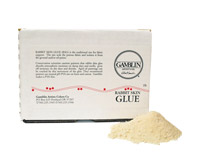
Next, it's time to break out the primer. No, I don't mean the Kilz. First, are you painting with oils or some other media? If you're painting with oils, you'll need different materials. To prime your surface for oils, you'll need to begin with something to seal it off. The most traditional sealant (called a size) is rabbit skin glue. Be aware, this is exactly what it sounds like; an animal by-product. If you're against using animal products, steer clear of this one. Rabbit skin glue serves as a sizing; a barrier between the fibers and the acidity of the oil paints. Without a size, over time oil paints will seep through surface fibers and eat them away, ruining the painting.
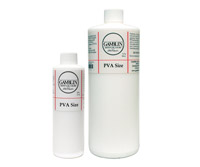
While rabbit skin glue is the traditional sizing, recent studies have shown that its hygroscopic qualities eventually cause cracking in oil paints. For the sake of your painting's longevity, you may be more interested in a modern alternative. Artists needing to size their canvas surface that don't want to use rabbit skin glue for one reason or another often use PVA (Poly Vinyl Acetate) sizing such as Gamblin's PVA Sizing. Unlike rabbit skin glue, PVA will not tighten the materials. So make sure your surface is stretched properly before applying the PVA.
When applying your sizing, keep in mind the point is to coat the fibers completely, so they're entirely sealed off from the acidity in oil colors. This means that soaking through to the back is not only acceptable, it's desirable. This is especially true if you have a slightly looser weave canvas, as the ground will likely "strike" through it. If you've sized your canvas properly, this is no cause for concern.
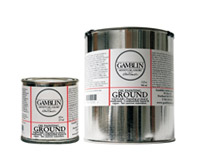
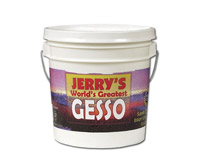
nce you've applied your sizing, it's time for the gesso, or ground. If you're painting with oils, you will probably want an oil ground. This is a non-absorbent ground that helps prevent sinking, a process where oil paints literally sink into the ground and lose their luster. Several companies make oil grounds. You might want to try Gamblin PVA Sizing or Williamsburg's Oil Grounds. (Be advised, Williamsburg's Oil Ground contains Lead Carbonate, a traditional pigment that is known to be harmful if handled improperly.) Apply two or more thin coats, depending on how smooth you want the surface.
If you're working with any other media, or you don't want to worry about specific oil grounds, then acrylic gesso is for you. With acrylic gesso, you do not have to size the surface. Simply apply two or more thin layers of the acrylic gesso, and you're ready to paint!
Canvas isn't the only surface out there to paint on. In fact, before they were made, wood panels were the most popular artist's support. Now, we have cardboard canvas panels, as well as gessoed wood and masonite panels. The following are some common canvas alternatives.
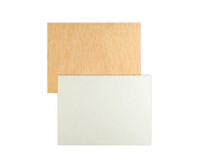
Canvas Panels: Wood, MDF, Paper Particleboard
What is you do not live the that you have to tighten your canvas? Or you may want to use a heavy medium that the stretched canvas can't support? Or maybe you want to do a couple of quick studies, but not waste your money on expensive lines? Enter canvas panels. If you're looking for a rigid support, you'll want a board with a Birch Wood Painting Panels base. If you want to do quick studies, or if you're looking for something less expensive, you might prefer a paper particleboard. A word of warning; in high humidity, SoHo Canvas Texture Painting Panels can warp. Keep that in mind when considering what sort of panel to buy.
Other Types of Panels: Ampersand, Gessoed Wood Panels
Before stretched canvas, artists painted on wooden supports. Today, there are many other rigid supports available. The company Ampersand has several lines of MDF supports with various grounds. For something less expensive, try their Ampersand Value Series Artist Panels, gessoed boards with a canvas texture. For a smoother support, Da Vinci has the Da Vinci Pro Ultra Smooth Gesso Panels line—no prepping required. Just unwrap and paint!
So now you've got a good idea what a canvas is, and everything you need to know. The only thing left is…which one is right for you? The lists below should point you in the right direction.
What If I Paint With:
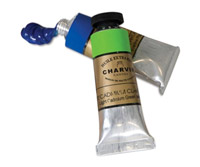
Oils
As an oil painter, you're using one of the oldest common paint types still in use today. Oil colors require special surfaces to bring out their full potential. Look for a canvas that is oil-primed. While oil colors can be used on acrylic primed surfaces, acrylic grounds are absorbent, which can cause the oil paint to 'sink'; that is, become dull. Conversely, if you are planning to do an underpainting in acrylic, then you will have to use the acrylic-primed surface, as acrylic cannot adhere to oil (but oil can adhere to acrylic). For a stretched oil-primed, try the Centurion Oil Primed Linen Canvas, or the Raphael Oil-Primed Linen Canvas. If you want to stretch your own you need oil primed canvas rolls. Try the Artfix Belgian Linen C-series rolls. And finally, if you're looking for a panel, we suggest the Centurion OP Professional Oil Primed Archival Linen Panels. Remember, if you don't underpaint with acrylics, oils can sink on acrylic primed. This can always be prevented by a layer or two of Oil Priming Materials.
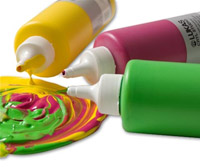
Acrylics
As an acrylic artist, you can paint on just about any kind of surface and still get excellent results. With acrylic, one doesn't have to worry about lengthy drying times or sinking, as with oil paint. When looking for a substrate to paint on with acrylics, look for the terms absorbent, acrylic-primed, universal, or gessoed. Look for: The Edge canvas, or for a heavyweight canvas we recommend the SoHo Urban Artist Heavyweight Stretched Cotton Canvas 1-1/2" Deep . Planning an odd size painting? Try the Paramount Roll Canvas. For a rigid painting surface, you may want to look into the Ampersand Museum Gessobord Panels.
For canvas rolls we recommend: Acrylic Primed Canvas Rolls
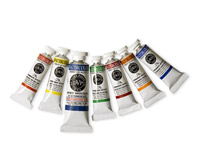
Watercolors
Beyond paper, surfaces are limited for the watercolorist. The best alternative is the Yes! Canvas, available in watercolor stretched canvas and YES canvas rolls. Yes! Canvas also has panels available. If you're looking for a rigid surface to paint on with your watercolors, you're in luck! Neither surface requires framing behind glass like watercolors normally do, but we do suggest a Krylon fixative.
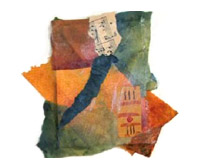
Mixed Media
If you're working with mixed media or collage, chances are you're using water-based mediums that can also be used with acrylic paints. Because of this, you can use the same surfaces acrylic painters use. Keep in mind though, that collage can quickly become too heavy for stretched canvas. If too much weight is placed on the surface, it will sag. If you're going to be placing a lot of foreign objects on the piece, or using a lot of medium, consider instead an MDF panel like the Da Vinci Pro Resist Grip Textured Gesso Panels. For lightweight collage, or mixed media, try the Yes! Multi-media Canvas. For a unique look, you might want to consider the Paramount Oval and Round Canvas.
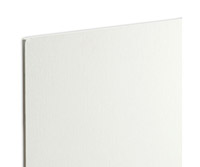
Economical
The least expensive supports are usually canvas panels with paper particleboard backing. In some cases, you get what you pay for. Particleboard is prone to warping in high humidity or if overworked. We've found that Creative Mark painting panels are less likely to warp than some other brands. Less expensive but super quality for art is the Practica Cotton Canvas is an excellent choice for better.
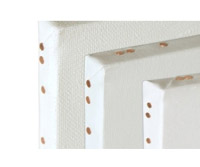
Luxurious
If you're looking for a top-of-the-line surface to paint on, you'll most likely be looking for linen. If you prefer stretching your own canvas, there is a broader range of finer options available, such as the New York Central® Unprimed Linen Canvas Blankets or the ArtFix French Linen Canvas Rolls. For an even higher grade canvas at a very affordable price: Superb Performance And Color Retention! Exclusive OP Enhanced Oil Priming.. choose Centurion Professional Oil Primed Linen Stretched Canvas.
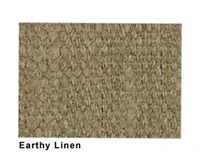
Heavy Duty
When working with large sizes, it's imperative to have a beefy canvas that will hold up to large sizes and heavy paint weight. Or sometimes, you just need to make as much of a statement as your paint does. "The Edge" is a heavy-weight cotton canvas, at 14oz. Heavy weight surfaces are more widely available in canvas rolls. Spectrum All Media Canvas comes in a hefty 15oz roll, but keeps a finer touch for finer detail.

Environmentally Friendly
Everyone is concerned about being 'green' these days, and rightfully so. Why not extend that environmental consciousness to your art? Charvin gummed jute is made from jute, a fibrous plant grown mainly in India. Renewable and being a plant that requires little pesticides or manual watering, the jute plant is definitely friendly to the environment. It's important to consider not just a product that's environmentally friendly, but a company that considers that in everything they do. Ampersand, the makers of Gessobord, Hardbord and the Value Series Artist's Panel, is one such company. They use only products from sustainable resources in their boards, and use no formaldehyde or volatile organic compounds.

Miniature
Looking for an extra small canvas? Need a small sized canvas to create small art on? Most brands go down to 6x8", maybe even 5x7". But any smaller, and you're out of luck, right? Not quite! The Edge Canvas makes 8x8", 6x6", 5x5", and even 4x4" size. Need something even smaller? Try the Paramount Ultra Mini Canvas, which are as small as 2x2"!
Magnetic Canvas
Ultra Mini Magnetic Canvas Perfect For Painting & Display! The same great Ultra Mini size but now with magnets built into the back to create easy bonding for magnetic surfaces. It's great for displaying on everything from appliances to magnetic white boards to art shows and schools. You can even attach an array of sizes to a metal sheet to paint and display all sorts of art. Great for painting, mosaics, displaying and much more!
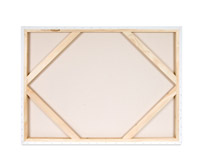
Extra Large
Sometimes you just need a really, really big canvas. Usually you'll see a sizes and brands go up to 30x40in and large. Some go larger, 36x48in, and on maybe. But what if that just isn't big enough? Try The Edge All Media Cotton Deluxe Stretched Canvas 2-1/2" Deep, which goes up to an impressive 60x72" size made for premium quality works and galleries.
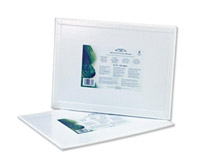
Beginner to Amateur
If you're just getting started, chances are you don't want to spend a lot of money on your painting surface. After all, what if you find out painting isn't for you? Or at the very least, you know your first paintings probably aren't going to be stellar—why waste money on what you might end up tossing out? For a cheaper grade that you can still frame if you pleasantly surprise yourself with a masterpiece, try the Practica line known for its super priming and heavier weight than other brands (see more details below). For cheap practice support, you can try canvas panels, like the Creative Mark Art Panels or SoHo Artist Cotton Canvas All Media PanelS, or canvas pads, which are just sheets of just the canvas paper to paint on.
If you want to dive in head-first and try stretching your own, or working really big, the army cotton duck canvas blankets are a great, inexpensive place to start. Worried about wrinkles, or prefer something already primed? Paramount canvas rolls are inexpensive, but quality.
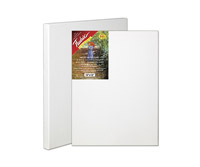
Intermediate or Hobbyist
If you've just started really getting into painting, or you've decided that, hey, you're pretty good!, you might want to move up to a better grade. For something still budget-friendly, we highly recommend Practica! Practica is one of most popular brands of canvas in the world. Or, if you're an oil painter, try the Centurion Oil Primed Linen. (Remember, the OP DLX cannot accept acrylic paint; if you under-paint with acrylics, you may want to try the Centurion 3/4" linen canvas.) Since you have some experience under your belt, consider exploring outside the box—the box of stretched canvas, that is.
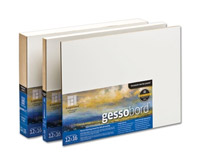
Professional
So, you’re a professional. You have your art hanging in galleries and people’s homes, and you have your own place at various shows. You have a whole different list of priorities than the beginning or hobbyist. You need a quality canvas with a good primer and that will last. If you’re looking for a professional, archival surface, you’ll most likely want linen. An inexpensive place to start is the Centurion canvas, which comes in oil or acrylic primed. If you prefer to stretch your own, options really open up for at the professional. If you need something smoother for portrait or fine detail work, you might like the Artfix Belgian linen, L84C (oil-primed) or L84U (acrylic-primed) series, the finest weave available on the market today.
Do I Have to frame It?
What your painting is on and what you’re going to do with it dictates whether you ‘have’ to or do not have to frame your painting. For starters, if you painted on a piece of canvas paper, of course you’re not going to just hang up a sheet of paper on a wall (the fridge is another story). The painting needs to be dry-mounted and framed, or secured in a frame with a backing behind glass.
If you’ve painted on a canvas panel or flat masonite/wood panel, and intend to show in a gallery, most galleries require these substrates to be framed. If you’re selling it or giving it away, you do not have to frame it. Keep in mind the community saying, ‘unframed paintings tend to remain unframed’. That beautiful painting you spent hours on may never make it up to the recipient’s wall if it doesn’t have the necessary accoutrements to just hang it on a nail and be done with it.
If your painting is on a canvas up to 1” deep, many galleries will accept this type of painting without a frame—as long as the sides are painted and there are no staples on the side—that is to say, the canvas is gallery-wrapped or you can use a stylish canvas floater frame .
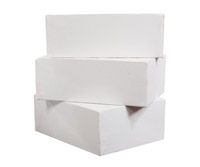
Framing Non-Rectangular and Very Deep Sizes
If your frame is 1.5" or deeper, has an unusual profile like the Float or Beveled canvas, or is oval-shaped, the good news is, you usually don't have to frame it. Actually, of the list I just mentioned, oval ones are really the only ones that can be framed. Unfortunately, this requires a framing shop, whether online or locally. Depending on the size, they may have something to fit your needs, or you may have to get it custom-cut. Custom cut frames can carry hefty price tags, so look out if you're particularly budget-conscious.
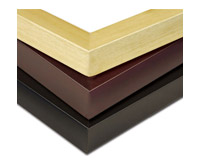
Framing Custom Sizes
If you have a regular or; rectangular style that's 1” or less deep that happens to be an unusual size, good news! Custom size frames don't have to cost an arm and a leg. If you’re looking for something simple, you can probably get the size you need from frame kits. If you do want a frame a little more ornate, Jerry’s does carry custom wood frames and custom metal frames for most budgets. And don't forget, if it is gallery wrapped, you may not have to frame it at all and can be hung with just D-rings and wire, or sawtooth hangers and many other picture hanging supplies
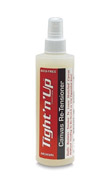
Common accessories are canvas carriers, that come in many shapes and sizes, but serve the same function: to keep anything from getting on your wet painting. Another tool for use that is not to be overlooked is the canvas tightener. This is a little spritzer bottle with a substance inside that immediately tightens the surface material without the hassle of stretcher keys. Most importantly, it's acid-free, so you don't have to worry about the integrity of your painting.
To See more we recommend to see our selection of: Canvas Tools & Stretching Supplies




Login and Registration Form
Customer Login
Already a customer ? Sign in now for the best experience!
* indicates a required field